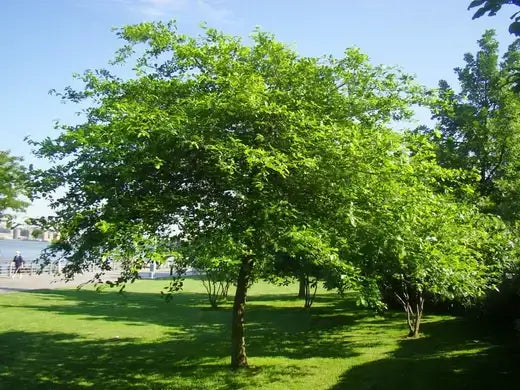Tupelo
Tupelo, Nyssa species, is a small genus of deciduous trees and is sometimes included in the subfamily of the dogwood family. There are many different species, and they are native to various parts of the world. These include areas of North America as well as locations throughout Asia. There are seven to ten species: the water tupelo, white tupelo gum, Ogeechee tupelo, Chinese tupelo, black tupelo (or black gum), and yuunan tupelo. The tupelo tree is considered a spectacular tree for fall colors by landscapers with its varying bright shades of orange, yellow, red, and purple. It is also an excellent shade tree with its great height and spread.
Hardy Plant Zone
The tupelo tree grows well within the hardiness zones 3 - 9
Mature Height
These trees can grow thirty to fifty feet high and twenty to thirty feet wide upon maturity. It has a slow growth rate of approximately one to two feet per year. The most extensive record tupelo tree was a staggering 144 feet tall with a spread of 95 feet.
Soil Requirements
It thrives in acidic, deep soil that is evenly moist. It grows well in loamy, sandy, rich, silty loam and well-drained soil. It does not tolerate a high PH.
Characteristics and Appearance
The tupelo tree has many appealing traits regarding landscaping and yard enjoyment. It grows oval with bark that has been said to resemble alligator hide that furrows with age and provides textural interest. It produces green-white flowers during the Spring. During September and October, its bluish-black fruit ripens, attracting various species of wildlife and birds.
The Tupelo leaves are three to six inches in length and alternate with an elliptical shape. Its Autumn leaves provide a spectacular show of bright colors ranging from yellow, orange, red, and purple. There are times these colors can all be seen on the same branch.
Another point of interest with the tupelo tree is its honey bee attraction. Bees are attracted to the fruits of the tree. When various tupelo species are combined, it gives honey a light and mild-tasting flavor. Tupelo honey is a favorite among honey producers.
Uses in Landscaping
They are excellent shade trees with a magnificent spreading canopy. Anywhere on the property with enough space to accommodate the tree where a cool shade is desired would be an ideal spot for this tree. These trees are a favorite among mammals and birds. That is something to remember when considering where to landscape this tree.
For wildlife enthusiasts who love bird-watching, an ideal location for this tree is where these can be enjoyed and viewed. The tupelo tree attracts wild turkey, wood ducks, many species of birds, raccoons, squirrels, and white-tailed deer through its berry production and twigs.
The tupelo tree provides a beautiful and enjoyable display of nature from Spring until late Autumn. This tree offers Spring-time flowers that resemble petal-less spirea, a shiny and bright green canopy of leaves in the Summer, small fruits that attract all sorts of wildlife and birds in the early fall, and a collage of bright colors that erupt in Autumn.
It adds beauty and interest to the landscape during the winter months with its unique bark and horizontal branches. Not only does it offer ever-changing beauty through the seasons, but it also provides a beautiful shady area to sit beneath its great canopy. When considering these, the tupelo tree is a perfect addition to a yard or landscaping. The tupelo tree is a beautiful addition to the yard and a favorite of birds, animals, and honey producers.


